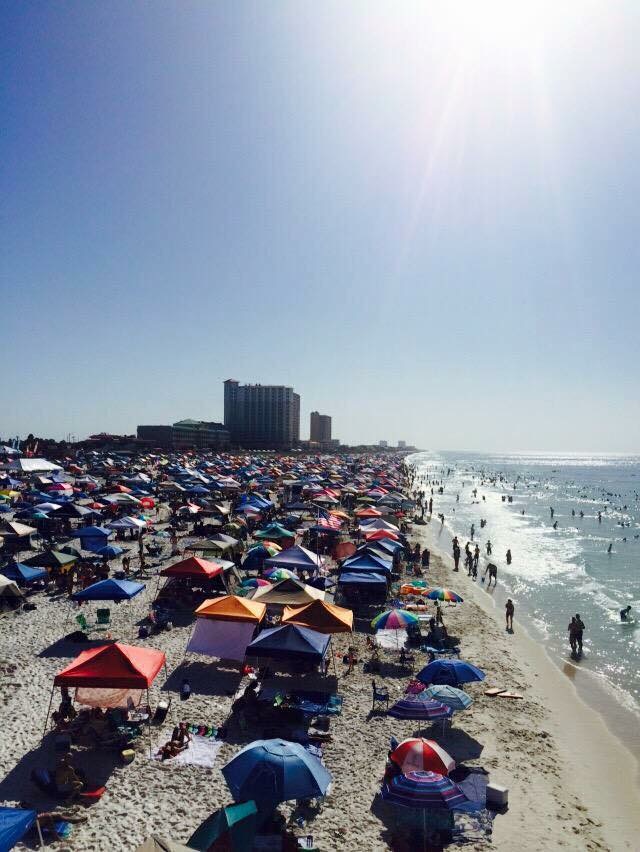
by Laura Tiu | Mar 12, 2016
It is that time of year again. Spring Break brings locals and visitors back to the beach for fun in the sun. It is important to remind folks that part of having fun is playing it safe. At the beach, this means knowing and following some pretty basic safety guidelines.
Not all beaches have lifeguards present, you have to be responsible for your own safety. When visiting the beach, it is important to consider the tide and surf conditions. To minimize the risks of drowning or serious injury, a uniform warning flag program was developed for use by Florida’s beachfront communities. Florida’s beach warning flag program uses flags in four colors accompanied by interpretive signs along the beach to explain the meaning of each color in both English and Spanish. Please follow the guidelines and flags posted.
You also need to check for the presence of rip currents. Rip currents are powerful currents of water moving away from the shore. They can pull even a strong swimmer out to sea. It is best to not enter the water where a rip current is present. However, if you find yourself caught in one, try to relax and don’t fight the current, swim out of the current parallel to the shore and swim to shore when you no longer feel the pull of the current.
Protect your skin. Just one blistering sunburn in childhood or adolescence more than doubles a person’s chance for developing melanoma later in life. Racking up more than five sunburns at any age also doubles the risk for melanoma. Keep sunburn at bay by properly applying sunscreen of SPF 15 or higher. Try to spend some time in the shade, wear a hat and sunglasses to protect your eyes. Remember to hydrate by drinking plenty of water too.
It is good to know a little bit about and appreciate the ocean life you might meet on the beach. Shark attacks aren’t common, especially in shallow shore areas, but always be on the lookout. Shells on mussels, clams and oysters can be very sharp so be careful walking near them. Some species of jellyfish have tentacles that contain venom and can sting you. Avoid them if you can. Learn about the animals you will find at the beach and you will be able to co-exist with little risk.
Many ocean creatures need our protection. Sea turtles and many shorebirds are protected and there are things you can do to help them. For sea turtles, keep the beach clean (remove all trash and furniture), dark (turn off lights on beach and don’t use flashlights) and flat (fill in any holes you dig so that turtles don’t become trapped). In fact, it’s recommended that you take only pictures and leave only footprints. Stay away from nesting shorebird habitat. Many beaches do not allow you to bring your pets to the beach for health and safety reasons and to protect venerable wildlife. Be sure to know the rules before you bring Fido to the beach.
Finally, please help keep the beach tidy. When your visit is over, take back everything you brought. Food scraps attract unwanted animals, fishing line injures and kills birds and other wildlife and plastic is harmful to both the environment and the animals that sometimes mistake it for food. Abandoned beach furniture and toys can obstruct sea turtle nesting and hatching. The best policy is to leave the beach cleaner than you found it.
Have a good time at the beach. Take a little time to learn and follow the safety rules that are there for your protection. Practice good citizenship by caring for and conserving the beach and ocean ecosystems in order to keep them beautiful in the present and for future generations.
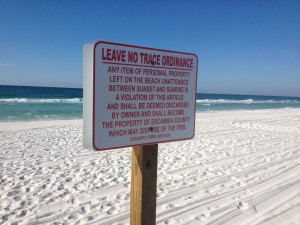
Many counties in the panhandle have lighting and barrier ordinances to protect wildlife and workers.
Photo: Rick O’Connor
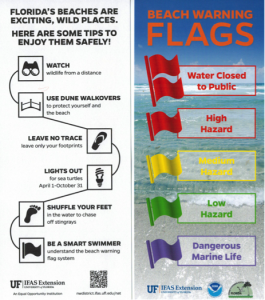
Follow these beach safety tips for helping your family enjoy the beach while protecting coastal wildlife.
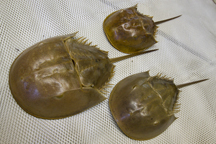
by Rick O'Connor | Mar 11, 2016
Talk about weird and cool at the same time! The horseshoe crab is one of the oldest living species we have in the Gulf of Mexico. Fossils of this animal date back to almost 500 million years… this is before there was such a thing as fish! The separating of Pangea, the rise and fall of the dinosaurs, oh what stories these guys could tell! And they are here today, trudging along in the soft sands of estuaries along the Atlantic and Gulf coasts… but they seem to be on the decline. After all they have been through… they may be slipping away.

Horseshoe crabs breeding on the beach.
Photo: Florida Sea Grant
Actually, horseshoe crabs are not crabs at all. They belong to the same large group of animals the crabs belong to, Arthropods, but differ from true crabs in that they have fewer jointed legs and no antennae. They are actually more closely related to spiders and scorpions. There are 4 species remaining on Earth. Limulus polyphemus is the local variety with the other three living in Asia. They are tolerant of a wide range of environmental conditions. Huge swings in water temperature and salinity do not bother them. This is not surprising considering all of the environmental changes that have occurred since the species first appeared on the planet. They are scavengers, plowing through the soft bottom of estuaries, they feed on worms, mollusk, and whatever else their crop-gizzard system can breakdown. Their protective shell deters many predators; most horseshoe crabs meet their fate on the beach – where they must go to breed.
Breeding occurs all year in Florida. It typically takes place three days before and after the new or full moon. The smaller males come near shore and patrol for the oncoming females. As the females are intercepted the males will use their “hook” to hold on and the pair ride onto the beach. This usually happens at night (though not always) during the peak of a spring high tide. The female digs a small depression and deposits between 200 and 300 eggs, the male fertilizes them, and the female buries them. They leave the young on their own for a month, at which time the next spring tide arrives and the larva, which resemble trilobites, emerge. Many fall prey to shorebirds and many adults actually become stranded on the beach during nesting and die.
So why the population decline?
Well, they do tolerate large swings in environmental change, so increase temperatures, rainfall, salinities, do not bother them. Studies have shown that they are actually quite tolerant of many of the pollutants, including oil, we discharge into our bays – though mercury is a problem for the developing trilobite larva. Along the Atlantic coast the animals are collected for bait and the biomedical industry. Horseshoe crabs are used in eel traps and there are several medical uses for their blood. Some biomedical industries collect the crabs, remove some of the blood, and return them – but not all survive this. A big problem they are facing, and this would be closer to home, is the loss of nesting habitat. Seawalls, jetties, groins, and coastal development in general have disturbed nesting beaches.
That said, they seem to be making a comeback on Pensacola Beach. There have been sightings at both Big and Little Sabine. We would like to record where they are nesting in the panhandle. If you would like to help – the full moon for the next few months will occur on March 22, April 22, May 21, and June 20. The new moon will occur March 8, April 7, May 6, and June 4. If you do see a horseshoe crab please contact me at (850) 475-5230, or email at roc1@ufl.edu.
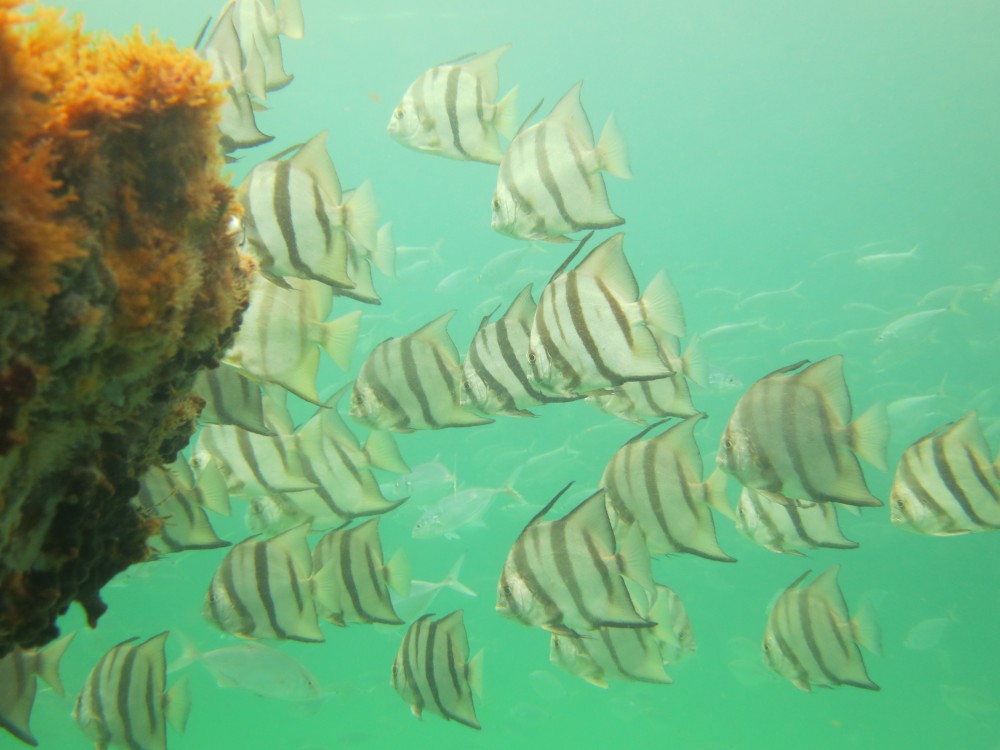
by Rick O'Connor | Mar 11, 2016
It’s that time of year… the air is warming and spring break has begun. Crowds of locals and visitors have begun to descend on area beaches to enjoy the panhandle sunshine and waterways, and safety is always a concern.
One of the many water activities visitors can enjoy are snorkeling our nearshore reefs. From St. Andrew’s to Perdido Key, panhandle counties provide several snorkel options that can be reached from shore. However, there are hazards that all need to be aware of and, with a few behavior changes, the risk can be reduced.
Know your limitations… Some of snorkel spots are an easy swim – some you can even walk to – but others can be a 500 ft. swim or more. Nearshore snorkel reefs must have 6 ft. of water clearance above them at low tide – to avoid collisions with boats – and this can be mean they are considerable distance from shore. If you are not a strong swimmer you need to consider a snorkel vest that can be inflated while you swim to the location. Once there you can deflate and enjoy. Keep in mind that this depth requirement may require a 20 ft. dive to reach the bottom.
- Sun protection… with your face in the water observing the marine life you become comfortable and relaxed, but your back and legs will still be exposed to the sun. Recent studies have indicated that sunscreen has been a problem for coral polyps in the Keys but you will need to protect yourself. If you are not interested in sunscreen a long sleeve t-shirt or surfing chaff-guard should be considered.
- A dive flag… they are actually required for snorkeling in Florida. With the number of jet ski and pontoon rentals exploring some of the same areas you will be snorkeling, this flag is a must. If snorkeling in open water, a dive buoy can be used in lieu of a dive flag. The dive buoy can have either 3 or 4 sides but must display dive symbols. The symbols must be at least 12×12 inches. However, if displaying from a boat you must continue to use a standard dive flag at least 20×24 inches. In open water you must remain within 300 ft. of the dive marker. If snorkeling in a channel you must remain within 100 ft.
- Marine life… Some of the inhabitants on local snorkel spots can deliver a painful bite or sting. It is not recommended that any snorkeler try to capture any form of marine life; in state and national parks it is prohibited. Spearfishing may be illegal in some locations, check with local dive shops to determine. The state has several non-take species for spearfishing. Those can be found at http://myfwc.com/fishing/saltwater/recreational/spearing/
- As always pay attention to the Beach Safety Flags. These are posted for your safety. “Red” = stay out of the water, conditions are not good; “Yellow” = enter with caution, should be a strong swimmer; “Green” = all is good, enjoy; “Purple” dangerous marine life have been seen in the area – generally these are jellyfish but could mean frequently seen sharks or other hazardous marine life.

This sea turtle frequents the nearshore snorkel reef at Park East in Escambia County.
Photo: Robert Turpin

These range markers allow snorkelers to find the reef when swimming.
Photo: Rick O’Connor
There are a lot of interesting organisms to be found on our local snorkel reefs and it will be a great addition to your day at the beach. With a few behavior changes on your part, and adhering to regulations, the adventure should be an enjoyable and safe one.








